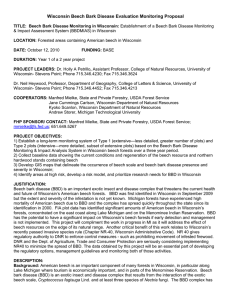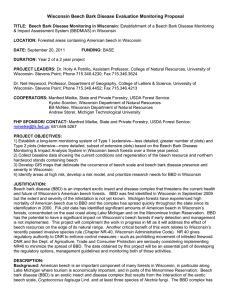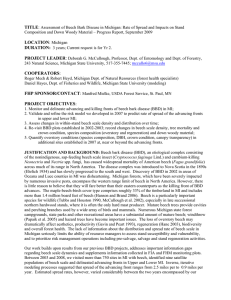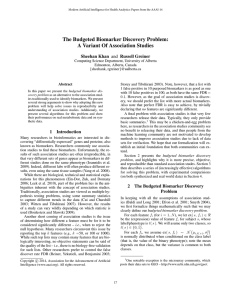NC-EM-07-03
advertisement
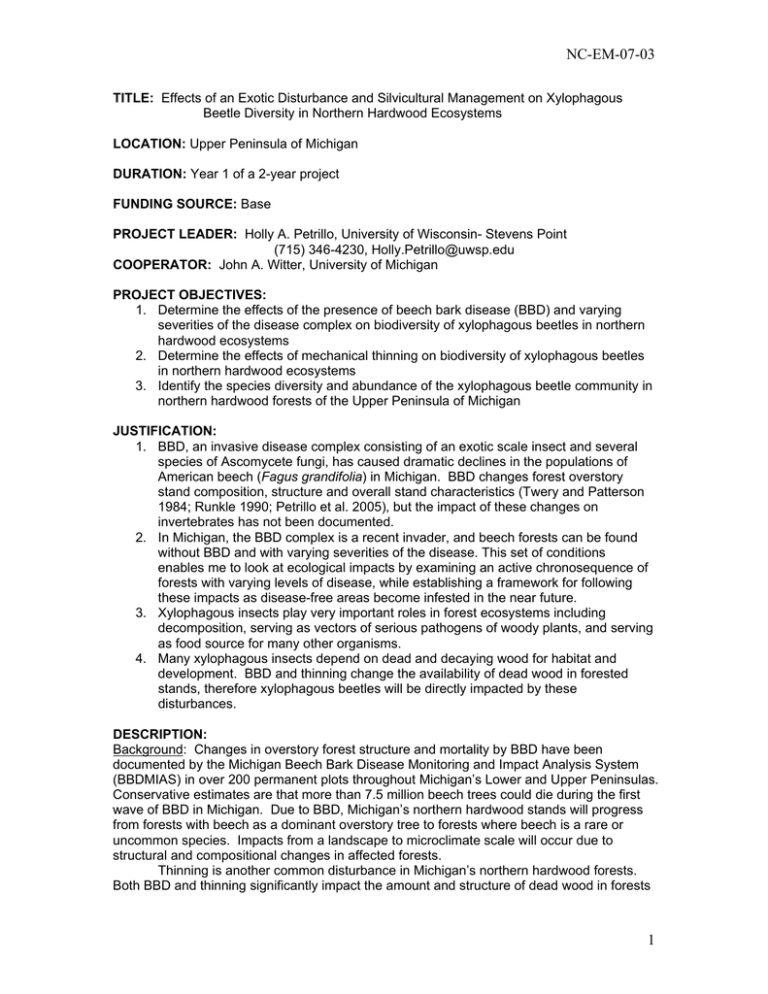
NC-EM-07-03 TITLE: Effects of an Exotic Disturbance and Silvicultural Management on Xylophagous Beetle Diversity in Northern Hardwood Ecosystems LOCATION: Upper Peninsula of Michigan DURATION: Year 1 of a 2-year project FUNDING SOURCE: Base PROJECT LEADER: Holly A. Petrillo, University of Wisconsin- Stevens Point (715) 346-4230, Holly.Petrillo@uwsp.edu COOPERATOR: John A. Witter, University of Michigan PROJECT OBJECTIVES: 1. Determine the effects of the presence of beech bark disease (BBD) and varying severities of the disease complex on biodiversity of xylophagous beetles in northern hardwood ecosystems 2. Determine the effects of mechanical thinning on biodiversity of xylophagous beetles in northern hardwood ecosystems 3. Identify the species diversity and abundance of the xylophagous beetle community in northern hardwood forests of the Upper Peninsula of Michigan JUSTIFICATION: 1. BBD, an invasive disease complex consisting of an exotic scale insect and several species of Ascomycete fungi, has caused dramatic declines in the populations of American beech (Fagus grandifolia) in Michigan. BBD changes forest overstory stand composition, structure and overall stand characteristics (Twery and Patterson 1984; Runkle 1990; Petrillo et al. 2005), but the impact of these changes on invertebrates has not been documented. 2. In Michigan, the BBD complex is a recent invader, and beech forests can be found without BBD and with varying severities of the disease. This set of conditions enables me to look at ecological impacts by examining an active chronosequence of forests with varying levels of disease, while establishing a framework for following these impacts as disease-free areas become infested in the near future. 3. Xylophagous insects play very important roles in forest ecosystems including decomposition, serving as vectors of serious pathogens of woody plants, and serving as food source for many other organisms. 4. Many xylophagous insects depend on dead and decaying wood for habitat and development. BBD and thinning change the availability of dead wood in forested stands, therefore xylophagous beetles will be directly impacted by these disturbances. DESCRIPTION: Background: Changes in overstory forest structure and mortality by BBD have been documented by the Michigan Beech Bark Disease Monitoring and Impact Analysis System (BBDMIAS) in over 200 permanent plots throughout Michigan’s Lower and Upper Peninsulas. Conservative estimates are that more than 7.5 million beech trees could die during the first wave of BBD in Michigan. Due to BBD, Michigan’s northern hardwood stands will progress from forests with beech as a dominant overstory tree to forests where beech is a rare or uncommon species. Impacts from a landscape to microclimate scale will occur due to structural and compositional changes in affected forests. Thinning is another common disturbance in Michigan’s northern hardwood forests. Both BBD and thinning significantly impact the amount and structure of dead wood in forests 1 NC-EM-07-03 where these disturbances occur. Standing dead and downed wood (DW) serves as an important habitat component for many invertebrate and vertebrate groups (Maser et al. 1979; Hunter 1990; Lindgren and MacIsaac 1999). Structural diversity provided by DW increases biological diversity in forested stands (Marra and Edmonds 1998; McGee et al. 1999) and managing for DW has become recognized as necessary for the maintenance of biodiversity. The disturbances created by exotic forest pests and diseases and the effects on native biodiversity need to be documented to better understand the magnitude of the disturbances and to raise awareness of the ecological consequences exotic invaders have on our native fauna. This research will advance our understanding of how human activities, such as movement of exotic species and silvicultural management, ultimately impact the ecosystems upon which we depend. Methods: a.Treatment types. Treatment types in this study involve a combination of two factors, each with multiple levels: (1) Presence of exotic beech scale (two levels: no scale, heavy scale [≥85% of the trees have ≥15% of their bole covered with beech scale]); and (2) Silvicultural treatment (three levels: no silvicultural treatment, recent selection cut [in the past 2 years], older selection cut [in the past 10–14 years]). Therefore, a total of 6 treatment types will be used, and five stands will be selected to represent each treatment type, making 30 stands (USFS land, Hiawatha NF) available for this study. Five stands will adequately represent each treatment type and the natural variation found between natural forest stands. Stands will be chosen from the BBDMIAS based on the availability of the aforementioned treatment types. Data from the BBDMIAS will also be used to compare stand-level variables including species composition, basal area, volume of downed woody material, and tree mortality, and other stand-level factors between the different treatment types. b. Arthropod sampling. Biodiversity of xylophagous beetles will be evaluated using flightintercept traps. A general lure will be placed in each trap to attract wood-boring beetles and other beetles associated with dead wood. Six traps will be placed along transects in each stand, each trap 40 meters apart. Six traps will provide a representative sample of the flying xylophagous beetles in each stand based on previous studies (Hammond et al. 2004). Traps will be opened for one week during the months of May- August, 2007 and 2008. In addition to flight-intercept trapping, meander surveys (hand collections) also will be conducted as part of the xylophagous beetle evaluation. During the surveys, litter will be hand sorted for wood-boring and other xylophagous beetles in the field, and refuges such as rocks, tree root flares, stumps, snags and downed woody debris will be examined. This type of targeted search covering specific microhabitats provides more complete collection of this taxonomic group because it better includes those species that are less mobile or that carry out their activity and movement in cryptic areas such as inside of large, downed woody items or under the soil surface instead of moving across the forest floor. It also allows more inclusion of small, highly agile species that do not fly often and may avoid flight-intercept traps. Finally, employing this technique in addition to flight-intercept traps will allow descriptions of microhabitat associations to be made and will reduce biases encountered when only implementing one trapping technique. PRODUCTS: Results from my research regarding wood-boring and other xylophagous beetle seasonal activity and habitat distributions will be useful for future biodiversity assessment and management of northern hardwood forests of the Great Lakes region. This research will be useful for resource managers making decisions on how to deal with BBD, how much and what types of dead wood to leave during thinning or other management actions, and possibly how to manage stands if an exotic wood-boring species invades an area. Results will be published in peer-reviewed journals focusing on the Great Lakes region so land managers and scientists in this region will have easy access to the results. Management recommendations may also be outlined as an extension bulletin or DNR report to make sure 2 NC-EM-07-03 that not only scientists and managers are informed but also the public is educated of the findings. These data will also be presented at scientific meetings, workshops or any other appropriate or requested venue to share information with practicing managers and scientists. SCHEDULE OF ACTIVITIES YEAR 1: Hire student to help Holly Petrillo with field work; Scout selected plots from the BBDMIAS to ensure their suitability for use for this project; Set traps in selected sites, Collect insects in flight intercept traps for one week each month during June-August; Perform meander surveys to collect xylophagous insects from wood and litter; Coordinate with John Witter to collect overstory stand information; Identify insects collected; Analysis of data on stand information and xylophagous beetles (collected during summer 2007 and from previous preliminary studies); Write report on progress. YEAR 2: Set traps in selected sites, Collect insects in flight intercept traps for one week each month during June-August; Perform meander surveys to collect xylophagous insects from wood and litter; Coordinate with John Witter to collect overstory stand information; Identify insects collected; Analysis of data; Write final report. COSTS YEAR 1 Administration Procurements Indirect Costs Year 1 Total YEAR 2 Administration Procurements Indirect Costs Year 2 Total Two Year Totals Item Salary Overhead Travel Equipment Supplies 19% off campus Item Salary Overhead Travel Equipment Supplies 19% off campus Requested FHM EM Funding 4,329 1,926 2,912 2,100 2,054 2,531 $15,852 Requested FHM EM Funding 4,545 2,114 3,038 630 2,054 2,352 $14,733 $30,585 Other- Source Funding 2,100 53 3,000 300 1,000 Source McIntire-Stennis UW-SP MS MS MS $6,453 Other- Source Funding 2,100 53 3,000 Source MS UW-SP MS 1,000 MS $6,153 $12,606 REFERENCES Hammond, H.E.J. 1997. Canadian Entomologist 129: 1009-1033. Hunter, M.L.,Jr. 1990. Prentice-Hall Career & Technology, Englewood Cliffs, NJ. 370p. Lindgren, B.S. and A.M. MacIsaac. 1999. In Shea et al. (eds.), Symposium Proceedings, Ecology and Management of Dead Wood in Western Forests, Nov 2-4, 1999, Reno, NV. Maser, C., R.G. Anderson, K. Cromack, Jr., J.T. Williams, and R.E. Martin. 1979. In Thomas, J.W., ed. Wildlife habitats in managed forests: the Blue Mountains of Oregon and Washington. USDA-FS Agricultural Handbook 553. Washington, D.C. McGee, G.G., D.J. Leopold, and R.D. Nyland. 1999. Ecological Applications 9: 1316-1329. Petrillo, H. A., J. A. Witter, and E. M. Thompson. 2005. In: Evans C.E., J.A. Lucas and M.J. Twery (eds.) BBD: Proceedings of the BBD Symposium, Saranac Lake, NY June 16– 18, 2004. USDA-FS, Northeastern Research Station. GTR NE-331. Runkle, J.R. 1990. Bulletin of the Torrey Botanical Club 117: 409-419. Twery, M.J. and W.A. Patterson III. 1984. Canadian Journal of Forest Research 14: 565-574. 3




